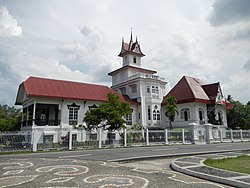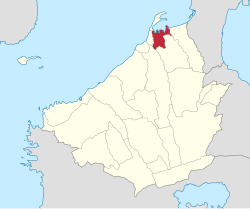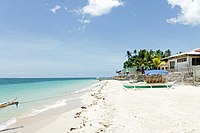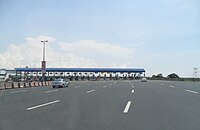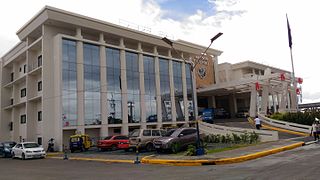
Bacoor, officially the City of Bacoor, is a 1st class component city in the province of Cavite, Philippines. According to the 2020 census, it has a population of 664,625 people, making it the 15th most populous city in the Philippines and the second largest city in the province of Cavite after Dasmariñas.
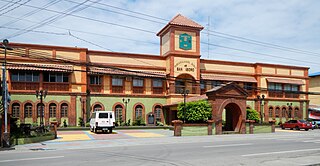
San Isidro, officially the Municipality of San Isidro, is a 2nd class municipality in the province of Nueva Ecija, Philippines. According to the 2020 census, it has a population of 54,372 people.

Famy, officially the Municipality of Famy, is a 5th class municipality in the province of Laguna, Philippines. According to the 2020 census, it has a population of 16,791 people, making it the least populated municipality in the province.

Magdalena, officially the Municipality of Magdalena, is a 4th class municipality in the province of Laguna, Philippines. According to the 2020 census, it has a population of 27,816 people.

Maragondon, officially the Municipality of Maragondon, is a 3rd class municipality in the province of Cavite, Philippines. According to the 2020 census, it has a population of 40,687 people. The town is famous for its bamboo crafts, Mounts Palay-Palay–Mataas-na-Gulod Protected Landscape which includes Mount Pico de Loro, and various ancestral houses and structures important to Philippine history and culture such as Maragondon Church and the execution site and trial house of national hero Andres Bonifacio.

Imus, officially the City of Imus, is a 3rd class component city and de jure capital of the province of Cavite, Philippines. According to the 2020 census, it has a population of 496,794 people.

Tanza, officially the Municipality of Tanza, formerly known as Santa Cruz de Malabon, is a 1st class urban municipality in the province of Cavite, Philippines. According to the 2020 census, it has a population of 312,116 people. It has a land area of 95.59 square kilometers (36.91 sq mi), making it the third largest municipality by land area in the province.

Rosario, officially the Municipality of Rosario, is a 1st class municipality in the province of Cavite, Philippines. According to the 2020 census, it has a population of 110,807 people.
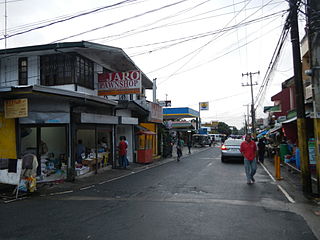
Alfonso, officially the Municipality of Alfonso, is a 1st class municipality in the province of Cavite, Philippines. According to the 2020 census, it has a population of 59,306 people.

Amadeo, officially the Municipality of Amadeo, is a 4th class municipality in the province of Cavite, Philippines. According to the 2020 census, it has a population of 41,901 people.

General Trias, officially the City of General Trias, formerly known as San Francisco de Malabon is a 1st class component city in the province of Cavite, Philippines. According to the 2020 census, it has a population of 450,583 people.

Ternate, officially the Municipality of Ternate, is a 4th class municipality in the province of Cavite, Philippines. According to the 2020 census, it has a population of 24,653 people.
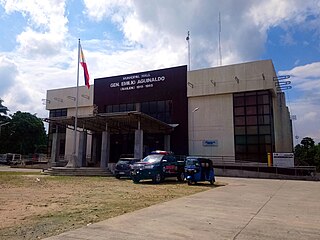
General Emilio Aguinaldo, officially the Municipality of General Emilio Aguinaldo, is a 5th class municipality in the province of Cavite, Philippines. According to the 2020 census, it has a population of 23,973 people.

Magallanes, officially the Municipality of Magallanes, is a 4th class municipality in the province of Cavite, Philippines. According to the 2020 census, it has a population of 23,851 people.

Mendez, officially the Municipality of Mendez-Nuñez, is a 4th class municipality in the province of Cavite, Philippines. According to the 2020 census, it has a population of 34,879 people.

Naic, officially the Municipality of Naic, is a 1st class municipality in the province of Cavite, Philippines. According to the 2020 census, it has a population of 160,987 people. Naic has a land area of 76.24 square kilometers.
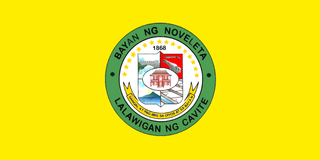
Noveleta, officially the Municipality of Noveleta, formerly known as Tierra Alta during the Spanish colonial era, is a 3rd class municipality in the province of Cavite, Philippines. According to the 2020 census, it has a population of 49,452 people.
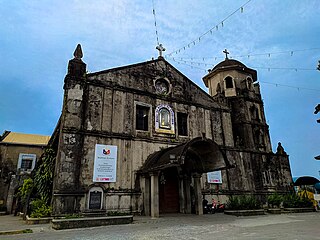
Silang, officially the Municipality of Silang, formerly known as Silan during the Spanish colonial era, is a 1st class urban municipality in the province of Cavite, Philippines. According to the 2020 census, it has a population of 295,644 people.

San Nicolas, officially the Municipality of San Nicolas, is a 5th class municipality in the province of Batangas, Philippines. According to the 2020 census, it has a population of 23,908 people. It is equivalent to 0.15% of the population in the Calabarzon area or 0.82% of the total population of Batangas province. These numbers are used to calculate the population density, which is 1,057 inhabitants per square kilometer or 2,740 inhabitants per square mile. The municipality makes up 0.73% of Batangas's total area, with a land area of 22.61 square kilometers or 8.73 square miles.

The Battle of Binakayan–Dalahican was a simultaneous battle during the Philippine Revolution that was fought on November 9–11, 1896 that led to a decisive Filipino victory. The twin battle took place at the shores of Binakayan, in the town of Cavite Viejo ; Dalahican and Dagatan in Noveleta; and, to minimal extent, in Imus and Bacoor towns in Cavite, Philippines that lasted for two days before the Spanish army retreated demoralized and in disarray. The result of the battle was the first significant Filipino victory in the country's history.
